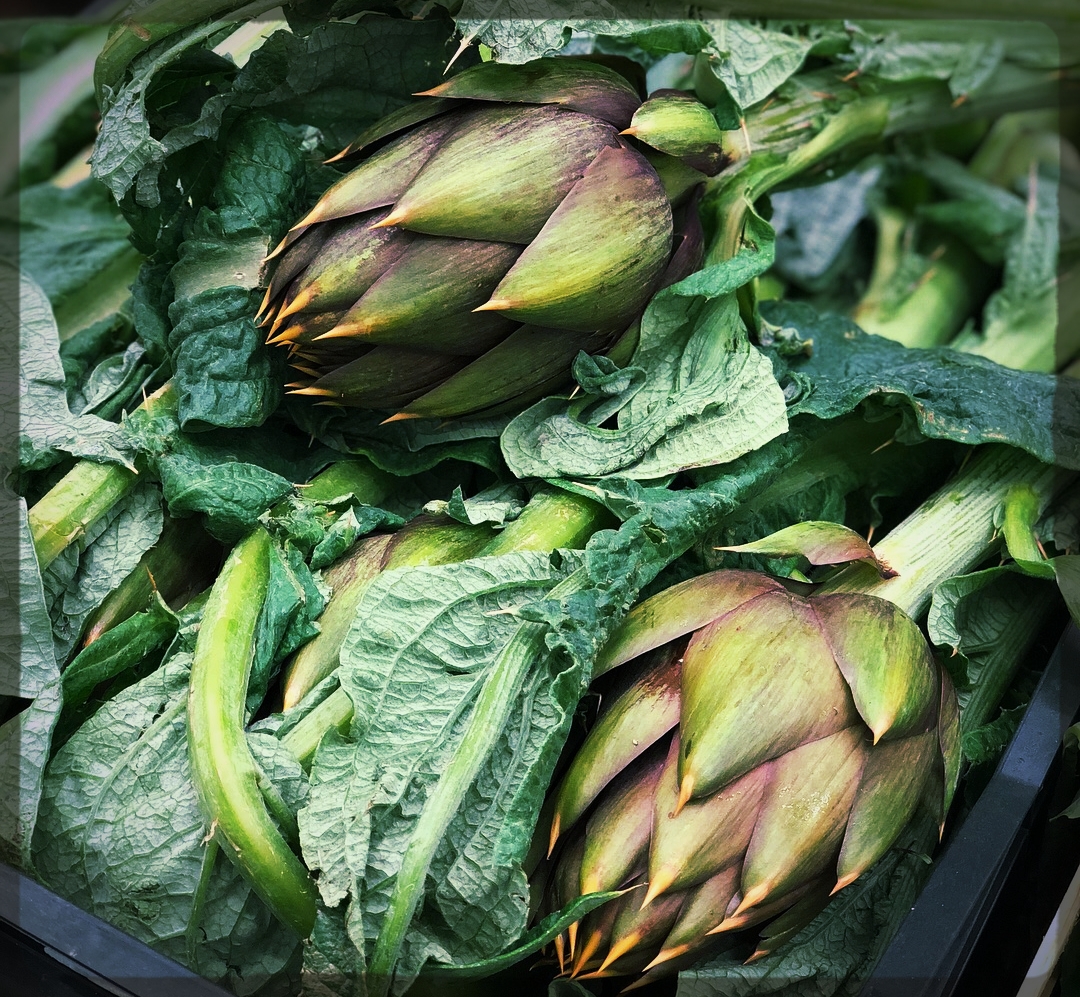January King Cabbages
Photo ©Evie Saffron Strands
FEBRUARY
January was a month when no two days seemed alike with oddly fluctuating temperatures but British-grown Brassicas and roots seemed to cope well. In our January Report, we promised you Sicilian Citrus and it was worth waiting for. Tarocco blood oranges, Nova Mandarins and Pink Grapefruits came on our direct-sourced pallets, and there is more citrus to look forward to this month. Vibrant pink spears of Forced Yorkshire Rhubarb brought more colour and acidity to our shelves and the first fronds of crunchy, salty Agretti arrived too.
Cauliflower
Photo ©Evie Saffron Strands
As we enter the last full month of winter, British-grown Brassicas and Root Vegetables are our seasonal staples and we look to southern Europe for more tender crops. Far from just a variation on green and brown, February’s colour palette is a vibrant one in the Puntarelle arch. Right now we have:
Vibrant pink-stemmed Yorkshire Forced Rhubarb.
Probably the last of the Seville Oranges for making bitter marmalade and buttery curd but there will be common Mandarins that work well too.
Un-treated, un-waxed Tarocco Blood Oranges, Nova Mandarins and Pink Grapefruits.
Deep red, sweet-sharp, Pomegranates.
English Purple Sprouting Broccoli, which is particularly good right now, and, creamy Cauliflowers.
From Portugal, we have Hispi Cabbage.
Crunchy, salty Italian Camone and Marinda Winter Tomatoes.
From Italy too, bunches of the Mediterranean succulent Barba di Frate/Agretti/Monk’s Beard, Purple Cauliflowers, Rainbow Chard, Bulb Fennel, Roman Artichokes and spikey Sardinian Artichokes.
Bitter-sweet Italian Greens this week are Puntarelle and Cime di Rapa and we have the first of the new season Courgettes.
Several varieties of colourful bitter-sweet pink and red Radicchio and milder-leaved yellow/green Endive.
Vitamin and mineral-rich British Brassicas including Savoy Cabbage, green and purple hued January King, blistered-leaved Black Cabbage/Cavolo Nero, Kale, Brussels Sprouts and Brussels Tops.
Orange-skinned Onion Squash.
Root vegetables including Celeriac, Jerusalem Artichokes, Swede, Beetroot and organic Heritage Carrots are all British grown this week, as are the Leeks.
Potato varieties this week are Cyprus and Desiree, Maris Piper, and waxy-fleshed La Ratte.
Fresh organic Ginger Root and Turmeric Root.
A freshly-stocked londonfermentary.com fridge.
Our Ferments
Photo ©Puntarelle&Co
Spikey Sardinian Artichokes
Photo ©Puntarelle&Co
Writing in the first few days of February, here is the produce we expect to have for you before this last full month of winter comes to a close:
Vibrant pink-stemmed Yorkshire Forced Rhubarb will continue throughout the month.
Un-treated, un-waxed Tarocco Blood Oranges, Nova Mandarins, common Mandarins and Pink Grapefruits will be joined by Lemons, Cedro and Kumquats.
Deep red sweet-sharp Pomegranates.
English Purple Sprouting Broccoli, which is particularly good in February, and creamy Cauliflowers. Hispi Cabbage from southern Europe.
Crunchy, salty Italian Camone and Marinda Winter Tomatoes.
From Italy too, bunches of the Mediterranean succulent Barba di Frate/Agretti/Monk’s Beard, Purple Cauliflowers, Rainbow Chard, Bulb Fennel, Roman Artichokes and spikey Sardinian Artichokes.
Bitter-sweet Italian Greens like Puntarelle and Cime di Rapa and new season Courgettes.
A variety of colourful, bitter-sweet pink and red Radicchio and milder-leaved yellow/green Endive.
Vitamin and mineral-rich British Brassicas including Savoy Cabbage, green and purple hued January King, blistered-leaved Black Cabbage/Cavolo Nero, Kale, Brussels Sprouts and Brussels Tops.
Orange-skinned Onion Squash.
Root vegetables including Celeriac, Jerusalem Artichokes, Swede, Beetroot and organic Heritage Carrots are all British grown this week.
English Leeks and Spanish Calçot onions.
Potato varieties this week are Cyprus and Desiree, Maris Piper, and waxy-fleshed La Ratte.
Fresh organic Ginger Root and Turmeric Root.
A freshly-stocked londonfermentary.com fridge.
Tarocco Orange
Photo ©Evie Saffron Strands
NEWS:
Have you tried our Pink Rhubarb Water Kefir? Also this week we have Orange Water Kefir made from some of our Sicilian Tarocco oranges.
Forced Yorkshire Rhubarb & Tarocco Blood Orange about to go in the oven
Photo ©Evie Saffron Strands
Here is a recipe using fruits that are at their best right now – that beautiful pink forced Yorkshire Rhubarb and Sicilian Blood Oranges. It’s adapted from Nigel Slater’s recipe in Tender Volume II and I can think of no simpler way to celebrate these two wonderful ingredients together.
Rhubarb with Blood Orange
(serves 4-6)
750g Rhubarb
4 Blood Oranges
Caster Sugar
1 vanilla pod
Heat the oven to 200C (180C Fan).
Rinse the rhubarb, cut off and discard the leaves. Chop the stems into short lengths and place in an oven-proof dish.
Remove the peel from two of the oranges, cutting away any white pith, then slice the fruit thickly and add it to the rhubarb.
Squeeze the juice from the remaining two oranges, and pour over the rhubarb.
Add a good tablespoon of sugar and the vanilla pod.
Cover the dish with foil and cook in the oven until the rhubarb yields to the pressure of a fork.
Check and adjust the sweetness to your taste.
Allow to cool then spoon into serving glasses, cover with clingfilm, and chill in the fridge for at least an hour but will keep for 2-3 days.







